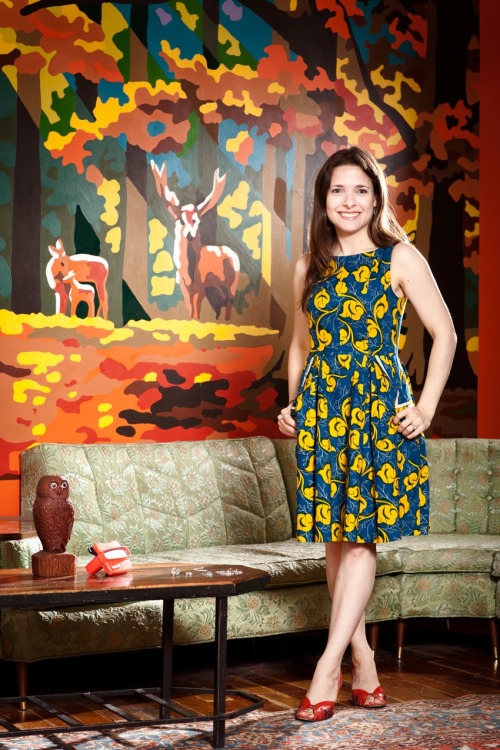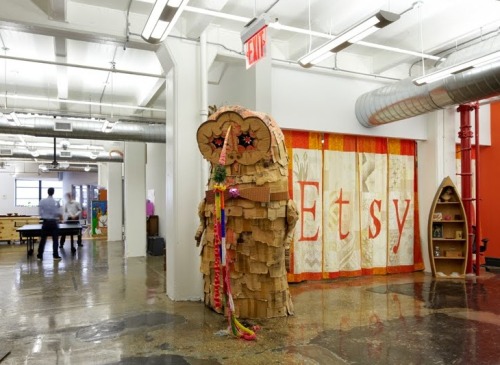TFG Exclusive: Q&A with Etsy's Counsel Sarah Feingold
 Friday, December 14, 2012
Friday, December 14, 2012 The legal side of any creative industry often goes unnoticed. Behind many of the top art exhibits, jewelry lines, book releases, movie productions, hit songs, clothing lines, or even start-ups are attorneys who help tie all the legal strings together and make it happen. While the increasing popularity of Fashion Law has brought more attention to these "artistic" lawyers, there are also music lawyers, museum lawyers, and entertainment lawyers that have bridged the gap between their legal knowledge and the creative world. Among all these specialized lawyers seems to be a running theme- they all have a creative streak of their own (be it a passion for art, movies, etc.) that needed an outlet.
Oh, to be an aspiring lawyer with a creative streak. If you are one, then you probably used to love to write, or play the piano, or take photographs, or make jewelry, but those were all "hobbies" and you continued to work your way into law school because there was something about the law that called to you and because you wanted a "secure" profession. And then half-way into your semester of Torts you realize, "what the hell did I sign up for?"
At least that was my personal experience. Fashion was always my creative outlet. And while I worked in fashion prior to law school, I continued to pursue my legal education only to eventually feel suffocated by the idea of not having a career that tapped into my creativity. But a light-bulb went off and I found a way to tie my legal expertise into my creative and entrepreneurial streak. Along the way, I had the honor of attending Fordham's Fashion Law Institute and meeting a group of brilliant, like-minded law students and attorneys- one of whom was Sarah Feingold, Counsel for Etsy.com.

Sarah Feingold, Counsel at Etsy.com
During our time at the Fashion Law Institute, Sarah and I bonded over our similar experiences. Except Sarah didn't have an "Institute" to guide her along in pursuing her goals. She tapped into her artistic streak as a lawyer before the industry began to really acknowledge this sub-specialty. Her exceptional career is of her own making. As in-house counsel for a leading e-commerce site, Sarah has had her fair share of experiences in lawyering creative types. From the artist-client that wants to sell his or her handmade goods online, to the entreprenuer who likes to take risks and think outside the box, Sarah's experience has made her a true expert in the cross-section of law, artistry, and technology. She not only authored an ebook entitled Copyright for Artists, but she also has her own jewelry line, Feingold Jewelry, on Etsy. In short, she is a rockstar. Despite her busy schedule, Sarah took the time to answer a few questions for TFG's interview series. We are so excited to share her story with our readers and hope that it will inspire more lawyers out there to do what they love. Check out her interview below!

Q: How did you come to work for Etsy?
A: Long story short, I studied metalsmithing in high school, in college and in law school. My goal was to be an attorney for artists and so in law school I focused my research on this area of law. While in law school I started writing the ebook Copyright for Artists. In 2006, while working at a Rochester NY law firm, I started selling my jewelry on Etsy.com and completely fell in love with the site. I loved the concept and the design. One day I reached out to Etsy's customer support team and one thing lead to another and I got into contact with Rob Kalin, Etsy's founder. After discussing some legal concepts and Etsy policies with Rob on the phone, I realized that Etsy did not have an in-house attorney. I immediately sent Rob my resume and booked a flight from Rochester, NY to New York City and notified Rob that I was coming to town for an interview. He hired me.
Q: What led to your decision to publish your ebook Copyright for Artists? What was the writing process like?
A: I completed all intellectual property classes offered by my law school and I knew there was so much left to learn. I approached my intellectual property professor, Laura Lape, and asked if we could work together on an independent study. This independent study turned into my ebook, Copyright for Artists. As for the writing process, I interviewed artists, I looked online for common small business questions, and, of course, I read legal books. Through my research I found that artists like visuals, so I made sure to include lots of graphs and illustrations in my finished product.



 Q&A
Q&A 
Reader Comments